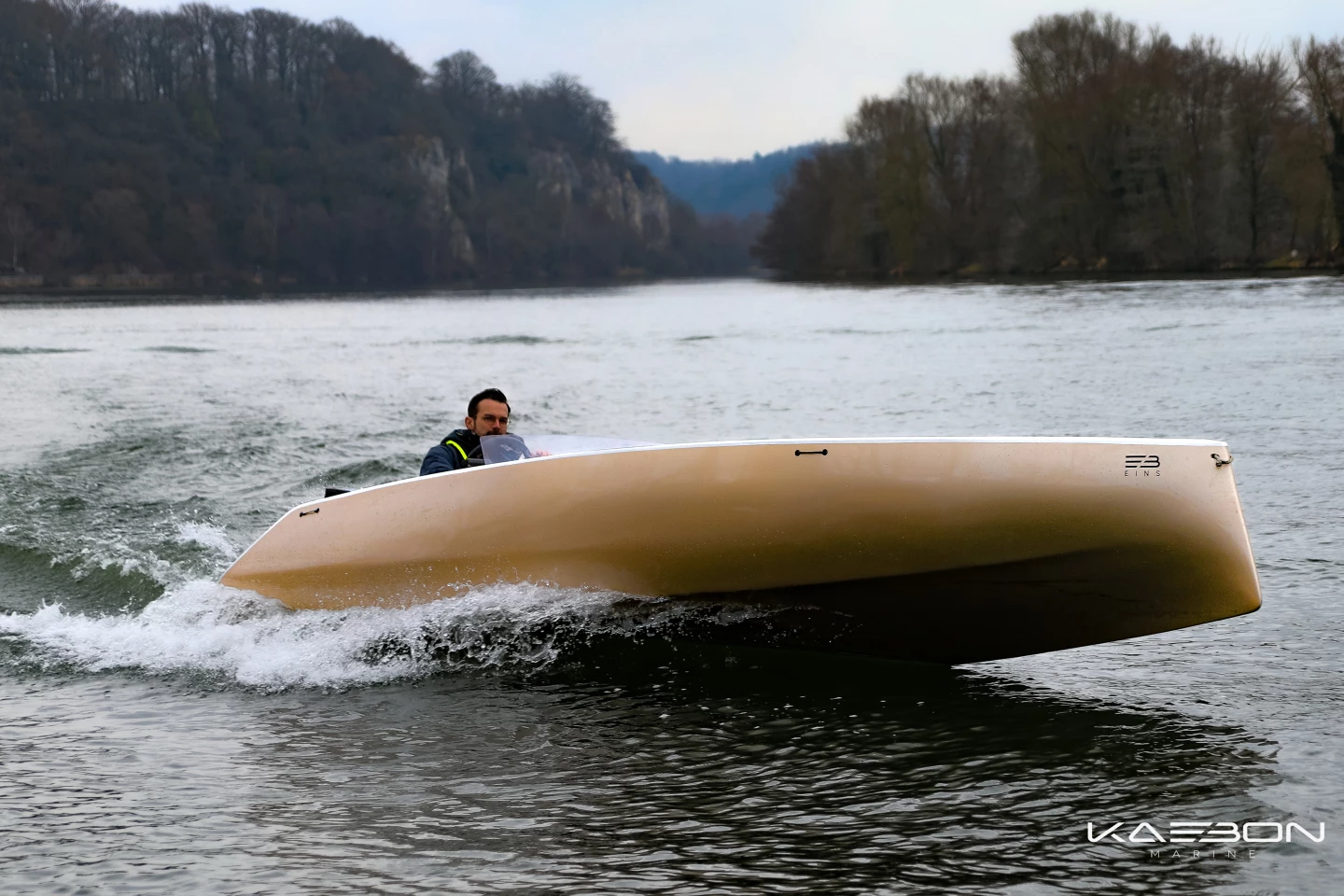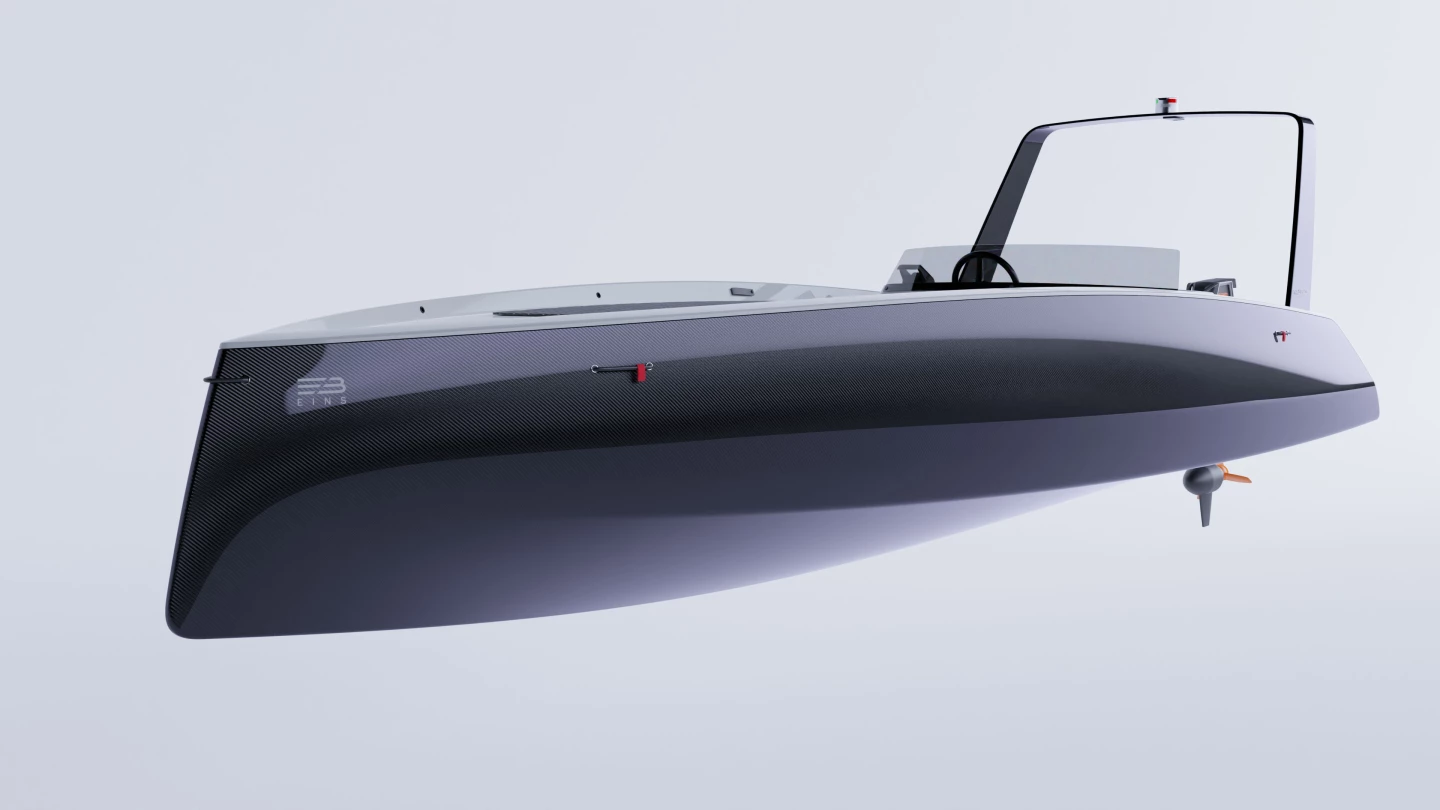Optimized for the lowest weight possible, the Kaebon EB Eins (One) electric boat is a smooth, monolithic hunk of carbon fiber designed to glide silently through the water. It's so lightweight, in fact, it can ride atop an SUV like a canoe, eliminating the need for a trailer or boat slip. Its sleek shape ensures that boaters enjoy their time on the water and get as much of it as possible, whether they're going full throttle or dialing it back for an afternoon-long cruise.
Imagine boating on a pristine alpine lake, your vessel the only sign of humanity within sight or earshot. You're surrounded by little more than raw nature and the impressionistic reflection it leaves rippling through the glassy water surrounding you. And yet, there you are running a loud, thundering gas engine and spewing all the exhaust and oily residue that come along with it.
That's not how that scene should play out. Instead, the surroundings should be respected like the living art they are, enjoyed via a boat that can coast along in near silence, leaving behind nothing more than a fading wake.
Kaebon was born in Munich, Germany with just such a vision, founded in 2021 by Kai Krause (a boat maker's name, if ever we've heard one) with the express goals of building the lightest motorboats in the world and advancing a cleaner, more sustainable form of boating.

"I thought it was about time to finally make power boating more sustainable without having to put pleasure on the back burner: power boating without regret," Krause recalls.
Krause and company referenced the lightweighting achievements of industries like aerospace and high-performance automotive in opting for an advanced composite build. Kaebon's first vessel, the EB Eins is crafted from vacuum-tempered foam-core prepeg carbon fiber, chosen for its combination of low weight, strength and durability.

To further bolster the vessel's potential for efficient propulsion, Kaebon carved the hull into a dramatic wedge-like shape with wave-piercing bow and long waterlines. Looking at it in its entirety – from sharply angled stern, through robust, swooping curves, to precisely sliced bow, the craft appears to us like a wave surging forward from the water, even when it's completely still.
The great thing about weight savings in vehicle construction is that they multiply naturally – light, efficient hull construction means a smaller powertrain can handle propulsion without undercutting performance, and such a powertrain saves weight compared to a larger one. Kaebon says the EB Eins can glide efficiently under power from a small motor, and it offers two Torqeedo e-drive options. The Cruise 6.0 premium drive promises propulsive power comparable to a 9.9-hp gas engine, while the Cruise 12.0 performance drive upgrades that to a 25-hp equivalent.

Kaebon continued to shave weight as obsessively as a hypercar designer when it came to smaller details, leaving behind ounces wherever it could. For instance, it replaced traditional metal cleats with textile loops that serve the same function but with a lesser weight penalty.
All that innovative weight optimization results in a 17.2-foot (5.3-m) e-boat with a base curb weight of just 196 lb (89 kg), which Kaebon qualifies as light enough to carry on the roof of a vehicle. Drivers will want to make sure their vehicle is capable of holding that dynamic weight, plus the weight of the rack system, and also keep tabs on overall payload, but the very idea of being able to roll to the water with a stylish four-person motorboat on the roof and no trailer in tow is certainly an intriguing one.

After boating season ends, the EB Eins can store away in a garage or backyard rather than requiring a special boat storage solution on water or land.
Kaebon hasn't published an estimated top speed, but it says the EB Eins will have enough battery power for 45 minutes at full performance and up to 10 hours when cruising slowly. The standard charger takes the battery from 0 to 100 percent in 10 hours, while the available quick charger does the same in under two hours.
Kaebon gave the EB Eins a Düsseldorf Boat Show debut earlier this year. The vessel is available to order now, and prices start at €59,900 (approx. US$65,400) for the Torqeedo Cruise 6.0-powered model and €74,900 ($81,775) for the Torqeedo Cruise 12.0 version.
Source: Kaebon (German)


























